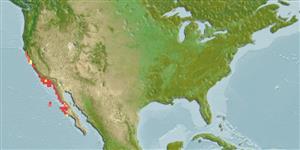>
Ovalentaria/misc (Various families in series Ovalentaria) >
Embiotocidae (Surfperches)
Etymology: Embiotoca: Greek, embios = permanent, for all the life + Greek, tokos,-oy = birth (Ref. 45335); jacksoni: jacksoni for A.C. Jackson , who first noted that black perch bore living young and brought this information to the attention of Alexander Agassiz (Ref. 4930).
More on author: Agassiz.
Environment: milieu / climate zone / depth range / distribution range
Écologie
marin démersal; profondeur 0 - 46 m (Ref. 2850), usually ? - 6 m (Ref. 2850). Subtropical; 40°N - 23°N, 124°W - 114°W
Eastern Pacific: Fort Bragg in northern California, USA to central Baja California in Mexico, including Guadalupe Island (off northern central Baja California).
Taille / Poids / Âge
Maturity: Lm ? range ? - ? cm
Max length : 39.0 cm TL mâle / non sexé; (Ref. 2850); poids max. publié: 700.00 g (Ref. 2850); âge max. reporté: 10 années (Ref. 56049)
Adults chiefly live in rocky areas near kelp, occasionally over sand bottom of coastal bays and around piers and pilings, and rarely in surf. Occur from intertidal areas to 46 m depth, but usually at about 6.1 m. Usually form small groups. Viviparous, female carries the developing young (Ref. 205).
Life cycle and mating behavior
Maturité | Reproduction | Frai | Œufs | Fécondité | Larves
Viviparous, female carries the developing young (Ref. 205).
Eschmeyer, W.N., E.S. Herald and H. Hammann, 1983. A field guide to Pacific coast fishes of North America. Boston (MA, USA): Houghton Mifflin Company. xii+336 p. (Ref. 2850)
Statut dans la liste rouge de l'IUCN (Ref. 130435)
Menace pour l'homme
Harmless
Utilisations par l'homme
Plus d'informations
RéférencesAquacultureProfil d'aquacultureSouchesGénétiqueElectrophoresesHéritabilitéPathologiesTraitementNutrientsMass conversion
Outils
Articles particuliers
Télécharger en XML
Sources Internet
Estimates based on models
Preferred temperature (Ref.
123201): 12.8 - 19.3, mean 16.7 °C (based on 64 cells).
Phylogenetic diversity index (Ref.
82804): PD
50 = 0.7500 [Uniqueness, from 0.5 = low to 2.0 = high].
Bayesian length-weight: a=0.02951 (0.01493 - 0.05834), b=2.99 (2.81 - 3.17), in cm total length, based on LWR estimates for this species & (Sub)family-body (Ref.
93245).
Niveau trophique (Ref.
69278): 3.3 ±0.38 se; based on food items.
Résilience (Ref.
120179): Milieu, temps minimum de doublement de population : 1,4 à 4,4 années (tm=1.5; tmax=10).
Fishing Vulnerability (Ref.
59153): Low to moderate vulnerability (29 of 100).
Nutrients (Ref.
124155): Calcium = 95.6 [52.9, 168.8] mg/100g; Iron = 1.15 [0.65, 1.96] mg/100g; Protein = 18.7 [17.7, 19.7] %; Omega3 = 0.264 [0.164, 0.428] g/100g; Selenium = 25.8 [13.2, 51.1] μg/100g; VitaminA = 6.99 [2.16, 22.97] μg/100g; Zinc = 0.694 [0.489, 1.013] mg/100g (wet weight);
